|
|
|
|
 Jeb Stuart: The Last Cavalier Biography of the dashing Confederate general is history at its best: fascinating, colorful, provocative. Includes portraits of Stuart's early life, training at West Point, the fateful decision to side with the South and action-packed battle scenes. 7 maps. 8 pages of photos. 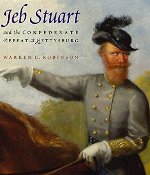 Jeb Stuart and the Confederate Defeat at Gettysburg Warren C. Robinson reassesses the historical record to come to a clearer view of Stuart's orders for the crucial battle (as well as what was expected of him), of his actual performance, and of the impact his late arrival had on the outcome of the campaign. Kindle Available 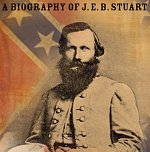 Cavalryman of the Lost Cause A Biography of J. E. B. Stuart James Ewell Brown Stuart was the premier cavalry commander of the Confederacy. He gained a reputation for daring early in the war when he rode around the Union army in the Peninsula Campaign, providing valuable intelligence to General Robert E. Lee at the expense of Union commander George B. McClellan |
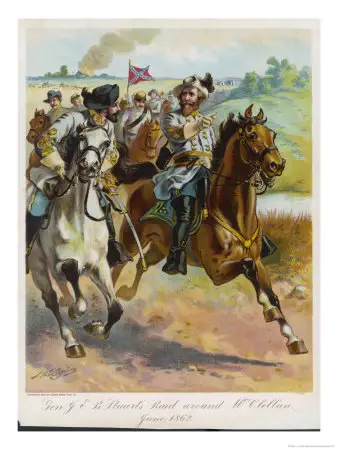
Confederate General J.E.B. Stuart Leads His Spectacular Raid Around the Union Forces 18 in. x 24 in. Buy at AllPosters.com Framed Mounted |
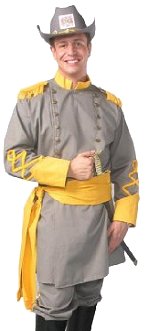 Adult Confederate Officer Uniform |
JEB Stuart rode around Hooker’s, then Meade’s, army on the 28th and 29th of June, 1863, operating under specific instructions received in a letter dated June 23 from General Lee. The letter, written in the hand of Walter Taylor, one of Lee’s aides, is recorded at page 23 of the Gettysburg Letterbook. Lee’s instructions were:
Stuart followed Lee’s instructions fairly well. With three cavalry brigades (Fitz Lee’s, Rooney Lee’s, and Wade Hampton’s), he crossed the Potomac the night of the 27th near Dranesville, passed through Rockville early on the morning of the 28th, capturing there a 125 wagon supply train heading for the Union army, and moved north toward Westminister, Meade’s selected base of operations, destroying telegraph lines. This forced Washington to communicate with Meade by courier, delaying considerably the time in which intelligence of rebel movements reached Meade’s headquarters at Middleburg. At Hood’s Mill, Stuart sent his brigades east and west along the line of the Baltimore & Ohio Railroad, destroying bridges. The night of the 28th, he scouted west, encountering the movement of the Union 2nd and 5th corps which were heading northeast toward Westminister and Union Mills. The morning of the 29th, Stuart entered Westminister, skirmishing with a Union cavalry detachment, scattering it and chasing it some distance toward Baltimore. Stuart spent the night of the 29th at Union Mills, with the Union 5th and 6th corps approaching. The morning of the 30th, after waiting for Kilpatrick’s cavalry division to pass his front in the direction of Hanover, Stuart followed and struck Kilpatrick’s rear in the streets of Hanover, diverting Kilpatrick from the purpose of his mission, locating the whereabouts of the rebel force known to be at York and Wrightsville. Breaking off the engagement in the afternoon, Stuart, with his captured train and prisoners, passed around York and headed northwest through Dover and Dillsburg, reaching Carlisle on July 1. Though Stuart did not actually open direct communication with Early’s division, he certainly “felt” Early’s presence, which explains his attack on Kilpatrick’s rear. Stuart knew that Early was at York on the 29th, that he would be moving west to join Ewell, as that was Lee’s plan as explained to him when he met with Lee at Paris, Fauquier County, on June 22. Indeed, White’s cavalry, operating with Early, had been to Hanover, burning railroad bridges, on the 29th, and Stuart’s pickets and scouts certainly came very close to contacting Early’s cavalry squadrons that were roaming the country around Hanover. As explained in The Gettysburg Letterbook, the controversy that developed over Stuart’s ride around Hooker was created, in large measure, by Charles Marshall, aide de camp to Lee, who claimed responsibility for drafting the text of Lee’s “official” Jan 1863 operations report. In the report, Lee constructed a story to support his public position that, when he entered Pennsylvania, he did not intend to draw the Union army into a general battle at Gettysburg; instead, the report says, he intended to move on Harrisburg, by way of Carlisle and the Wrightsville bridge, but, because he was operating without the benefit of reconnaissance reports from Stuart, he was forced by circumstance (the illusory threat of the Union army moving west of South Mountain) to move his army east of the mountains, which brought it “unexpectedly” upon Meade’s advance at Gettysburg. After the war was over, Marshall pushed this story in an address he made on the occasion of Lee’s birthday in 1896, and it was repeated by Frederick Maurice in the book, Charles Marshall, Aide de Camp to General Lee, published in 1925. It has been adopted by most civil war writers without questioning either Marshall’s credibility, or his veracity. In fact, Lee knew all he needed to know of the movement of the Union army, during June 27-July1, based upon the paramount principle of concentration both he and the Union army commander were constrainted by the realities of warfare to obey. Certainly Stuart’s cavalry could make no contribution to the battle itself, for cavalry had no place on a Civil War battlefield: The horsemen charging around would be wiped out quickly by the massed infantry fire of the long range rifles available, their range extending 1,000 yards, accurate fire at 700 to 800 yards. Cavalry stands on the sidelines when the King of Battle (infantry) is at work. The cavalry of both sides did collide in a separate battle on July 3rd, some three miles from the battlefield at Gettysburg, but it added no advantage to the scales of victory for either side. Joe Ryan Bibliography John S. Mosby, Stuart’s Cavalry in the Gettysburg Campaign, Moffat, Yard & Co. 1908
|
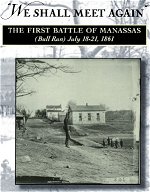 "We Shall Meet Again": The First Battle of Manassas (Bull Run), July 18-21, 1861 The First Battle of Manassas claimed the lives of approximately 878 soldiers and wounded another 2,489. With a battlefield stretching nearly five miles, 15,000 Union and 14,000 Confederate soldiers clashed for four fateful days |
 Civil War Model 1851 Naval Pistol Engraved Silver Tone / Gold Tone Finish and Wooden Grips - Replica of Revolver Used by Both USA / Union and CSA / Confederate Forces |
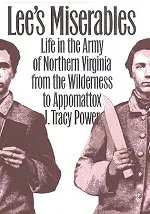 Lee's Miserables: Life in the Army of Northern Virginia from the Wilderness to Appomattox The words of the soldiers themselves provide a view of the army's experiences in camp, on the march, in combat, and under siege—from the battles in the Wilderness to the final retreat to Appomattox. |
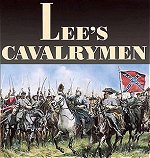 Lee's Cavalrymen: A History of the Mounted Forces of the Army of Northern Virginia, 1861-1865 The cavalry of the Army of Northern Virginia its leadership, the military life of its officers and men as revealed in their diaries and letters, the development of its tactics as the war evolved, and the influence of government policies on its operational abilities. All the major players and battles are involved |
Kindle Available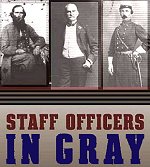 Staff Officers in Gray: A Biographical Register of the Staff Officers in the Army of Northern Virginia Profiles some 2,300 staff officers in Robert E. Lee's famous Army of Northern Virginia. A typical entry includes the officer's full name, the date and place of his birth and death, details of his education and occupation, and a synopsis of his military record. Two appendixes provide a list of more than 3,000 staff officers who served in other armies of the Confederacy and complete rosters of known staff officers of each general |
Kindle Available The Class of 1846: From West Point to Appomattox: Stonewall Jackson, George McClellan, and Their Brothers No single group of men at West Point has been so indelibly written into history as the class of 1846. The names are legendary: Thomas "Stonewall" Jackson, George B. McClellan, Ambrose Powell Hill, Darius Nash Couch, George Edward Pickett, Cadmus Marcellus Wilcox, and George Stoneman |
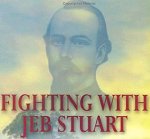 Fighting with Jeb Stuart: Major James Breathed and the Confederate Horse Artillery Biography of this important Southern officer, a brave and virtuous warrior who embodied all the qualities that made the Confederate Army one of the finest in history. Major Breathed was involved in eighty-six battles, engagements and skirmishes. |
Kindle Available Stonewall Jackson at Cedar Mountain At Cedar Mountain on August 9,1862, Stonewall Jackson exercised independent command of a campaign for the last time |
 Brandy Station Virginia, 1863: Major General Joseph "Fighting Joe" Hooker. |
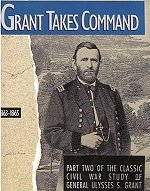 Grant Takes Command 1863 - 1865 A revelatory portrait of Ulysses S. Grant and the dramatic story of how the war was won. |